Results
-
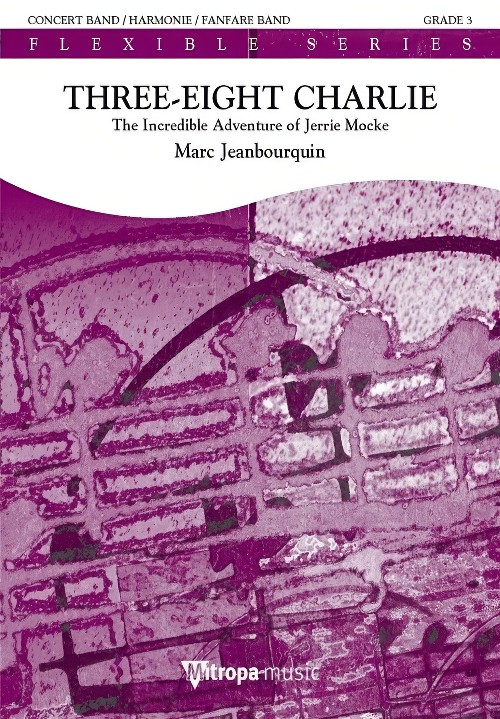 £84.99
£84.99Three-Eight Charlie (The Incredible Adventure of Jerrie Mocke) (Flexible Ensemble - Score and Parts) - Jeanbourquin, Marc
In 1964, the American aviator Jerrie Mocke was the first woman to fly solo around the world, in spite of her critics and the bad weather forecasted. She completed this journey in 29 days on board the "Spirit of Columbus", a single engine Cessna. This story inspired Marc Jeanbourquin. The aviator's determined nature appears from the very first bars, reflecting her mood before take-off. The hymn that follows illustrates the beginning of the flight, when all is going well. This leads to a calmer section, as if the aviator was letting herself be carried by the air currents above the clouds, lost in her thoughts. Then a more energetic passage brings her back inside the cockpit to confront the bad weather she encounters. She overcomes these difficulties to appear out of the clouds before a cheerful finale, as if nearing the finishing line. Welcome aboard for a flight around the world! First prize in the composition competition of the Swiss Music Association (Contest music 4th category 2020). Duration: 6.00
Estimated dispatch 7-14 working days
-
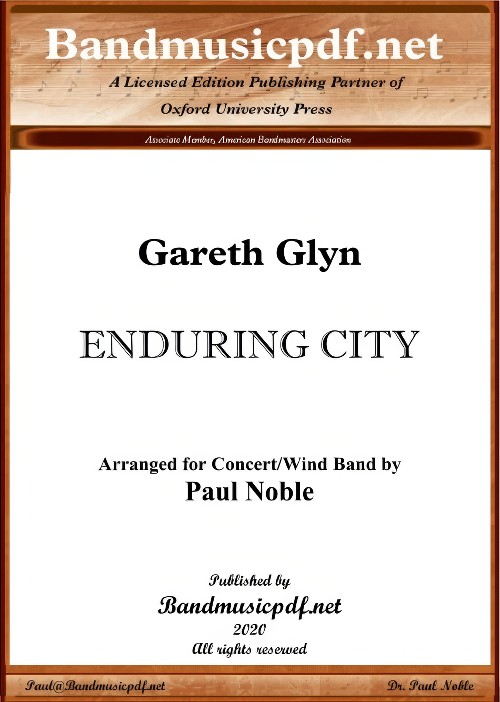 £295.00
£295.00Enduring City (Concert Band - Score and Parts) - Glyn, Gareth - Noble, Paul
Enduring City was composed to celebrate the 300th anniversary of the founding of New Bern, the first permanent seat of the colonial government of the state of North Carolina. It was first settled in 1710 by Swiss and German immigrants under the leadership of Christoph von Graffenried and and John Lawson. The 2010 composition was commissioned by the New Bern 300th Anniversary Committee and the City of New Bern, to portray the city in terms of its history, its present and its optimism for the future; the North Carolina Symphony gave its first performances, in venues throughout the state. Its one continuous movement is in well-defined sections. Most of the musical themes derive from names of people and places connected with New Bern, using letters that are also note-names, omitting those which are not. For example, the opening trumpets spell out E-B-E-D for New Bern ('R' standing for Re, which is D in fixed-doh sol-fa notation) and B-C-G for Baron Christoph von Graffenried. They are answered by the orchestra's "John Lawson, Gent.", the name on the cover of the co-founder's A New Voyage to Carolina. Lawson's questing and adventurous character is then suggested, accompanied by a "Carolina" note-name theme; and, after the Graffenried theme on solo horn, the music of both men combines for their voyage, culminating (on trumpets and trombones) in the founding of New Bern. The story of Tryon Palace, central to the city's history, is represented by echoes of the various kinds of music heard at the Governor's residence - fife and drum bands, minuets and the slaves' "Jonkonnu" festivals from Africa, celebratory fanfares and fireworks; the section reaches a climactic ending when all are combined. After a peremptory interruption by the snare drum, the perky fife theme is transformed to portray the conflicts that visited New Bern over the centuries, alternating with a new "grief" theme, which - when sounded by strings alone - leads to music of reconciliation and then of the natural beauty of the city's surroundings. A steady, lively rhythm underpins the final section, confidence - in the present and for the future. Echoes of previous themes are heard, but the closing peroration is reserved for a majestic and joyous statement of the name of New Bern itself.
Estimated dispatch 7-14 working days
-
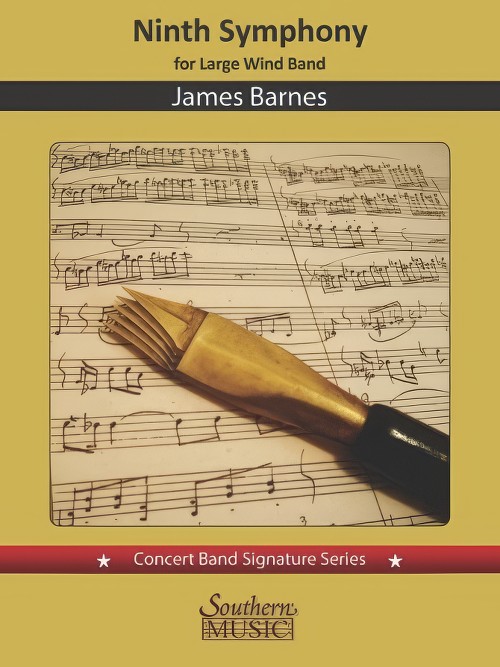 £309.99
£309.99Ninth Symphony (Concert Band - Score and Parts) - Barnes, James
Premiered on 21 September, 2018 in Lawrence, Kansas by The University of Kansas Wind Ensemble (Dr. Paul Popiel, conducting), James Barnes' Ninth Symphony was composed between January and late June of that same year. This large work was commissioned by a consortium of twenty-one college bands, community bands, professional bands and individuals to help mark the 70th birthday of the composer (b. 1949). It is an expansive forty-minute work in four movements, of which the composer writes, "This is my last symphony...this work represents a compendium of all that I have learned during the fifty years of composing and scoring for this wonderful new medium: the modern wind band." The first movement, subtitled Elegy, is based around G minor. It is the longest movement of the symphony. Tragic and despondent in character, it is cast in sonata-allegro form. The second movement is entitled Scherzo. Barnes claims that "I have always wanted to write a waltz," and that is how this movement is cast, in a modified rondo form in D minor. In contrast to the mood of the first movement, the scherzo is a delightful posy of expansive melody, splashy color, humor and rhythm. The third movement, which is in a modified tertiary form, is entitled Night Music. In contrast to the scherzo, this movement begins with a mysterious incantation, first displayed by solo Alto Flute. The music becomes even darker and more mysterious, while overall the movement effectively expresses an "otherworldly" mood, ending with a solo soprano offstage which suddenly emerges, eerily singing a modified version of the opening incantation. Cast in sonata-allegro form, the fourth movement is most definitely a rousing Finale, beginning with a brilliant fanfare and undergoing several mood transformations before emerging into the final coda, ending the symphony with an energetic splash of color. Duration: 40.00
Estimated dispatch 7-14 working days
-
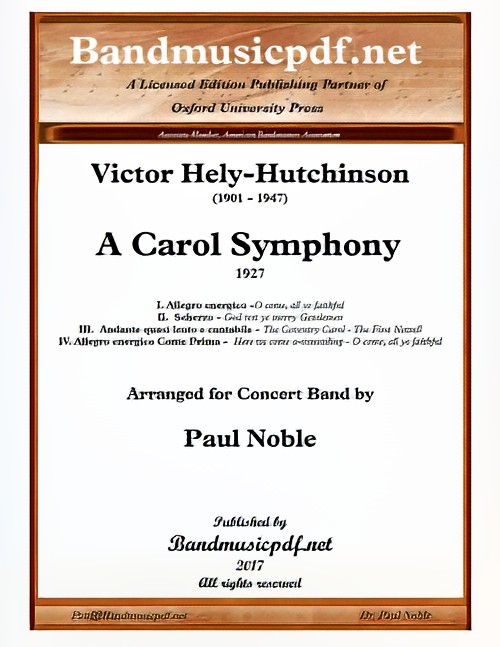 £450.00
£450.00A Carol Symphony (Concert Band - Score and Parts) - Hely-Hutchinson, Victor - Noble, Paul
Victor Hely-Hutchinson is best known for his Carol Symphony, composed in 1927, from which the third movement was used for the title music of the 1943 Children's Hour and 1984 BBC children's television adaptation of John Masefield's The Box of Delights, in particular the variation on the theme of The First Nowell. The first movement is based on O come, all ye faithful, with the second movement being based on God rest ye merry Gentlemen. The third movement includes The Coventry Carol and The First Nowell, with the final movement concluding with Here we come a-wassailing and a return to O come, all ye faithful. The movements may be performed separately. This arrangement for Concert Band adds not only another new seasonal offering, but a very strong piece for advanced bands around the world.
Estimated dispatch 7-14 working days
-
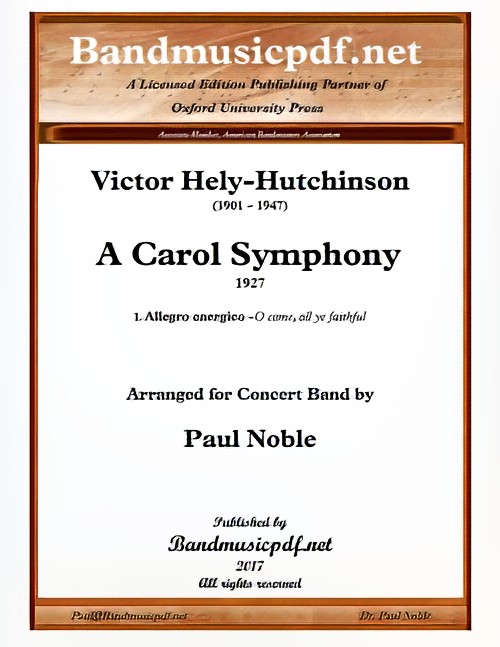 £125.00
£125.00A Carol Symphony, 1st Movement (Concert Band - Score and Parts) - Hely-Hutchinson, Victor - Noble, Paul
Victor Hely-Hutchinson is best known for his Carol Symphony, composed in 1927, from which the third movement was used for the title music of the 1943 Children's Hour and 1984 BBC children's television adaptation of John Masefield's The Box of Delights, in particular the variation on the theme of The First Nowell. The first movement is based on O come, all ye faithful, with the second movement being based on God rest ye merry Gentlemen. The third movement includes The Coventry Carol and The First Nowell, with the final movement concluding with Here we come a-wassailing and a return to O come, all ye faithful. The movements may be performed separately. This arrangement for Concert Band adds not only another new seasonal offering, but a very strong piece for advanced bands around the world.
Estimated dispatch 7-14 working days
-
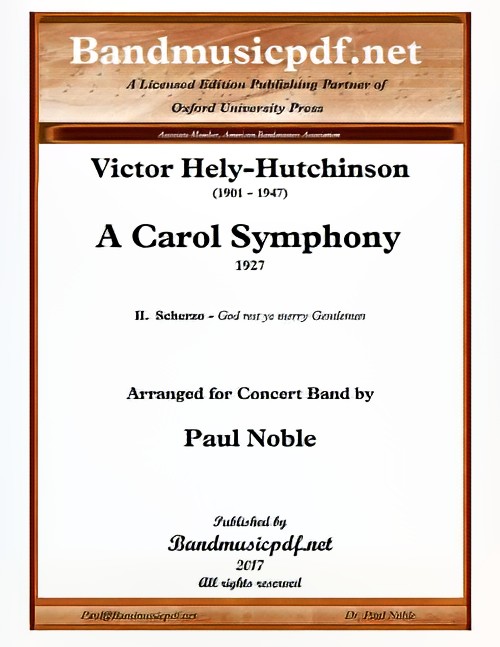 £125.00
£125.00A Carol Symphony, 2nd Movement (Concert Band - Score and Parts) - Hely-Hutchinson, Victor - Noble, Paul
Victor Hely-Hutchinson is best known for his Carol Symphony, composed in 1927, from which the third movement was used for the title music of the 1943 Children's Hour and 1984 BBC children's television adaptation of John Masefield's The Box of Delights, in particular the variation on the theme of The First Nowell. The first movement is based on O come, all ye faithful, with the second movement being based on God rest ye merry Gentlemen. The third movement includes The Coventry Carol and The First Nowell, with the final movement concluding with Here we come a-wassailing and a return to O come, all ye faithful. The movements may be performed separately. This arrangement for Concert Band adds not only another new seasonal offering, but a very strong piece for advanced bands around the world.
Estimated dispatch 7-14 working days
-
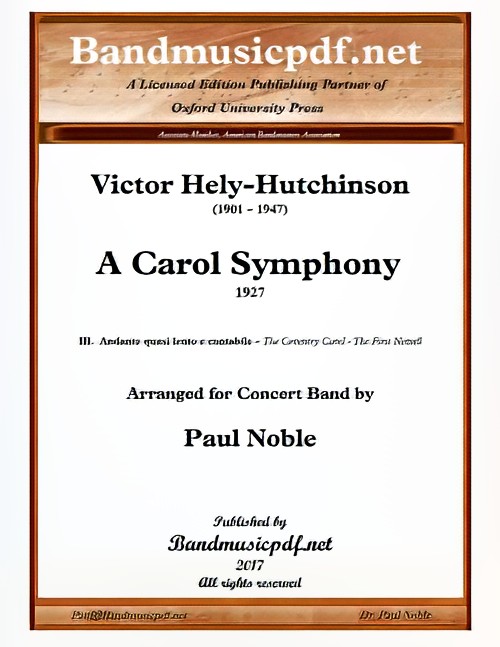 £125.00
£125.00A Carol Symphony, 3rd Movement (Concert Band - Score and Parts) - Hely-Hutchinson, Victor - Noble, Paul
Victor Hely-Hutchinson is best known for his Carol Symphony, composed in 1927, from which the third movement was used for the title music of the 1943 Children's Hour and 1984 BBC children's television adaptation of John Masefield's The Box of Delights, in particular the variation on the theme of The First Nowell. The first movement is based on O come, all ye faithful, with the second movement being based on God rest ye merry Gentlemen. The third movement includes The Coventry Carol and The First Nowell, with the final movement concluding with Here we come a-wassailing and a return to O come, all ye faithful. The movements may be performed separately. This arrangement for Concert Band adds not only another new seasonal offering, but a very strong piece for advanced bands around the world.
Estimated dispatch 7-14 working days
-
 £125.00
£125.00A Carol Symphony, 4th Movement (Concert Band - Score and Parts) - Hely-Hutchinson, Victor - Noble, Paul
Victor Hely-Hutchinson is best known for his Carol Symphony, composed in 1927, from which the third movement was used for the title music of the 1943 Children's Hour and 1984 BBC children's television adaptation of John Masefield's The Box of Delights, in particular the variation on the theme of The First Nowell. The first movement is based on O come, all ye faithful, with the second movement being based on God rest ye merry Gentlemen. The third movement includes The Coventry Carol and The First Nowell, with the final movement concluding with Here we come a-wassailing and a return to O come, all ye faithful. The movements may be performed separately. This arrangement for Concert Band adds not only another new seasonal offering, but a very strong piece for advanced bands around the world.
Estimated dispatch 7-14 working days
-
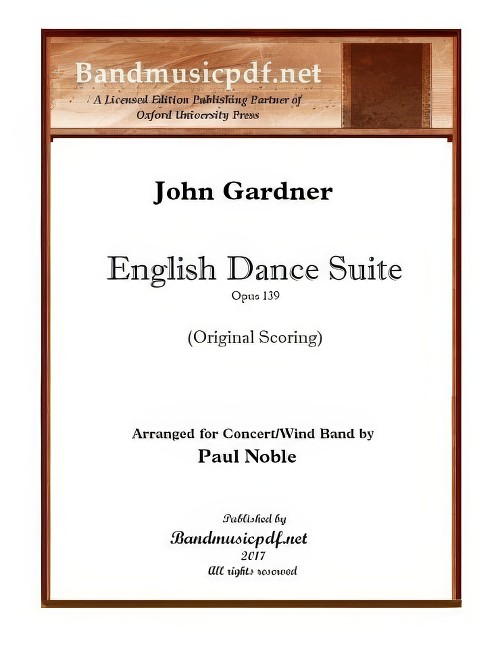 £495.00
£495.00English Dance Suite (Concert Band - Score and Parts) - Gardner, John - Noble, Paul
Original Scoring. Arranged for the modern Concert/Wind Band, scored for three trumpets, reasonable doubling of parts where the original musical effect is not altered so that players can have a more responsible and enjoyable experience, more legible parts with less doubling on one staff, etc. The piece is offered either as a complete suite of seven movements, and also as seven individual movements which may be purchased independently. The English Dance Suite was originally composed by John Gardner for Wind Band, and has been re-set for the modern Concert Band instrumentation. Both the original version, edited and type-set by Paul Noble, and this arrangement are first editions now available for purchase to bands around the world. The set of seven Renaissance dances depict John Gardner's love of Scottish music, the Renaissance heritage, and some of his own mischievous approach to music. The first movement, Chacony on a Golden Theme, reminiscent of the Allegro movement of Purcell's Golden Sonata, is much used as a vehicle for variation on a repeated short harmonic progression, often involving a fairly short repetitive bass-line which offered a compositional outline for variation, decoration, figuration and melodic invention. In this it closely resembles the passacaglia. The Alman originated in the 16th century as a duple metere dance of moderate tempo, already considered very old, with a characteristic double-knocking upbeat of one or occasionally three sixteenth notes. It appears to have derived from a German dance but no identifiable dance and no German dance instructions from this era survive. The Hornpipe, usually in 3/2 dance rhythm, is an Irish, Scottish and English dance. It is done in hard shoes, which are used to help keep track of how the dancer keeps in time. There are two variations of the hornpipe dance: fast and slow. Usually, more experienced dancers will do the slow hornpipe but younger dancers will start out with the fast hornpipe and then switch in later years. The Corranto is a 16th-century court dance characterized by short advances and retreats, in quick triple time. The Volta (Italian: the turn or turning) is an anglicised name from the later Renaissance. Its main figure consisted of a turn and lift in a sort of closed position. The Pavan is a slow processional dance common in Europe during the 16th century. The Reel, indigenous to Scotland, consists largely of quaver (eighth note) movement with an accent on the first and third beats of the bar.
Estimated dispatch 7-14 working days
-
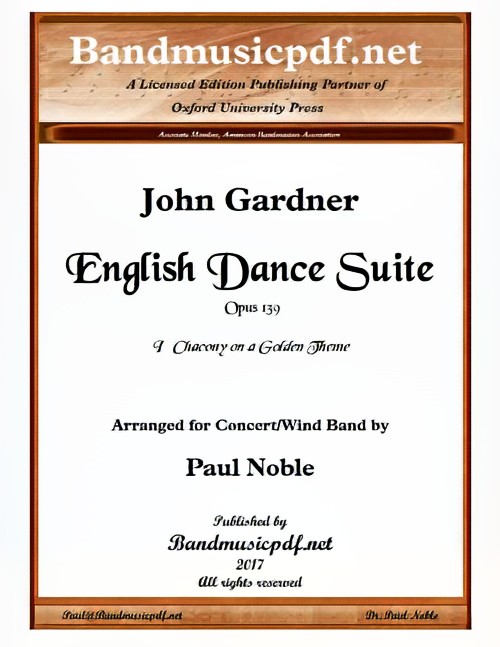 £125.00
£125.00English Dance Suite - I. Chacony on a Golden Theme (Concert Band - Score and Parts) - Gardner, John - Noble, Paul
Arranged for the modern Concert/Wind Band, scored for three trumpets, reasonable doubling of parts where the original musical effect is not altered so that players can have a more responsible and enjoyable experience, more legible parts with less doubling on one staff, etc. The piece is offered either as a complete suite of seven movements, and also as seven individual movements which may be purchased independently. The English Dance Suite was originally composed by John Gardner for Wind Band, and has been re-set for the modern Concert Band instrumentation. Both the original version, edited and type-set by Paul Noble, and this arrangement are first editions now available for purchase to bands around the world. The set of seven Renaissance dances depict John Gardner's love of Scottish music, the Renaissance heritage, and some of his own mischievous approach to music. The first movement, Chacony on a Golden Theme, reminiscent of the Allegro movement of Purcell's Golden Sonata, is much used as a vehicle for variation on a repeated short harmonic progression, often involving a fairly short repetitive bass-line which offered a compositional outline for variation, decoration, figuration and melodic invention. In this it closely resembles the passacaglia. The Alman originated in the 16th century as a duple metere dance of moderate tempo, already considered very old, with a characteristic double-knocking upbeat of one or occasionally three sixteenth notes. It appears to have derived from a German dance but no identifiable dance and no German dance instructions from this era survive. The Hornpipe, usually in 3/2 dance rhythm, is an Irish, Scottish and English dance. It is done in hard shoes, which are used to help keep track of how the dancer keeps in time. There are two variations of the hornpipe dance: fast and slow. Usually, more experienced dancers will do the slow hornpipe but younger dancers will start out with the fast hornpipe and then switch in later years. The Corranto is a 16th-century court dance characterized by short advances and retreats, in quick triple time. The Volta (Italian: the turn or turning) is an anglicised name from the later Renaissance. Its main figure consisted of a turn and lift in a sort of closed position. The Pavan is a slow processional dance common in Europe during the 16th century. The Reel, indigenous to Scotland, consists largely of quaver (eighth note) movement with an accent on the first and third beats of the bar.
Estimated dispatch 7-14 working days
